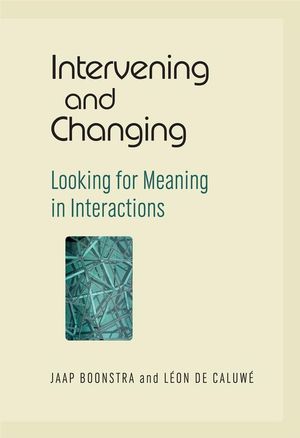Intervening and Changing: Looking for Meaning in InteractionsISBN: 978-0-470-51201-2
Hardcover
360 pages
October 2007
 |
||||||
About the Contributors.
Foreword.
Part One: Introduction and Theoretical Position.
1 Intervening and changing.
Looking for meaning in interactions.
Jaap J. Boonstra en Léon de Caluwé.
2 Methodology of the evidential.
Research and sense giving in processes of organizational development.
Adriaan Bekman.
Part Two: Telling Stories and Investigation Realties.
3 Storytelling as interactive intervention.
Applying the narrative approach in organizational change.
François Breuer.
4 Working with stories.
Narrative and dialogue as methods for learning, understanding and practice improvement.
Tineke Abma.
Part Three: Investigating History and Making History.
5 Learning histories in learning and change projects.
Making history with a passion.
Gerhard Smid in discussion with Godfried den Boer, Vittorio Busato, Liesbeth Halbertsma and Tonnie van der Zouwen.
6 Making History Together.
The Learning-history method in theory and practice.
Leen van Driel.
Part Four: Appreciation Inquiry and Realizing Innovations.
7 Future Search.
Inspiring, discovering, learning, seeing, imagining and doing combined.
Gemma van der Ploeg and Annemieke Stoppelenburg.
8 An organizational change project based on an appreciative approach.
A large group intervention in a chemical company.
Luk Dewulf and Luc Verheijen.
9 Learning and changing in an open space.
The dynamics of and in an open space event.
Carla Vliex.
Part Five: Looking for Patterns and Possibilities for Innovation.
10 Working interactively with causal loop diagrams.
Intervention choices and paradoxes in practical applications.
Hans Vermaak.
11 Intervening in processes of sensemaking.
A method for breaking through the closeness of organizational processes.
Hans de Sonnaville.
12 Interaction at work.
Interactive interventions in social interactions.
Dick van Ginkel and Mariëtte Thijssen.
Part Six: Learning to Reflect and Change.
13 Organizing in-dept learning.
Change as reflective sensemaking.
Brechtje Kessener and Katrien Termeer.
14 Methodology for increasing collective competence.
A context for co-creative change.
André Wierdsma.
15 Shaping a learning process and realizing change.
Reflection, interaction and cooperation through survey feedback.
Kilian Bennebroek Gravenhorst.
Part Seven: Reflecting on Acting and the Pursuit of Beauty.
16 Free conduct as a method of intervention.
‘Void leadership isn’t leading anywhere’.
Julien Haffmans.
17 Aesthetics in work processes in organizations.
A perspective for intervention.
Mathieu Weggeman and Irene Lammers.
Part Eight: Critical Reflection and a Look Ahead.
18 Intervention through interaction.
A comparative review.
Jac Geurts, Jurriaan Altena and Bart Geluk.
Index.



